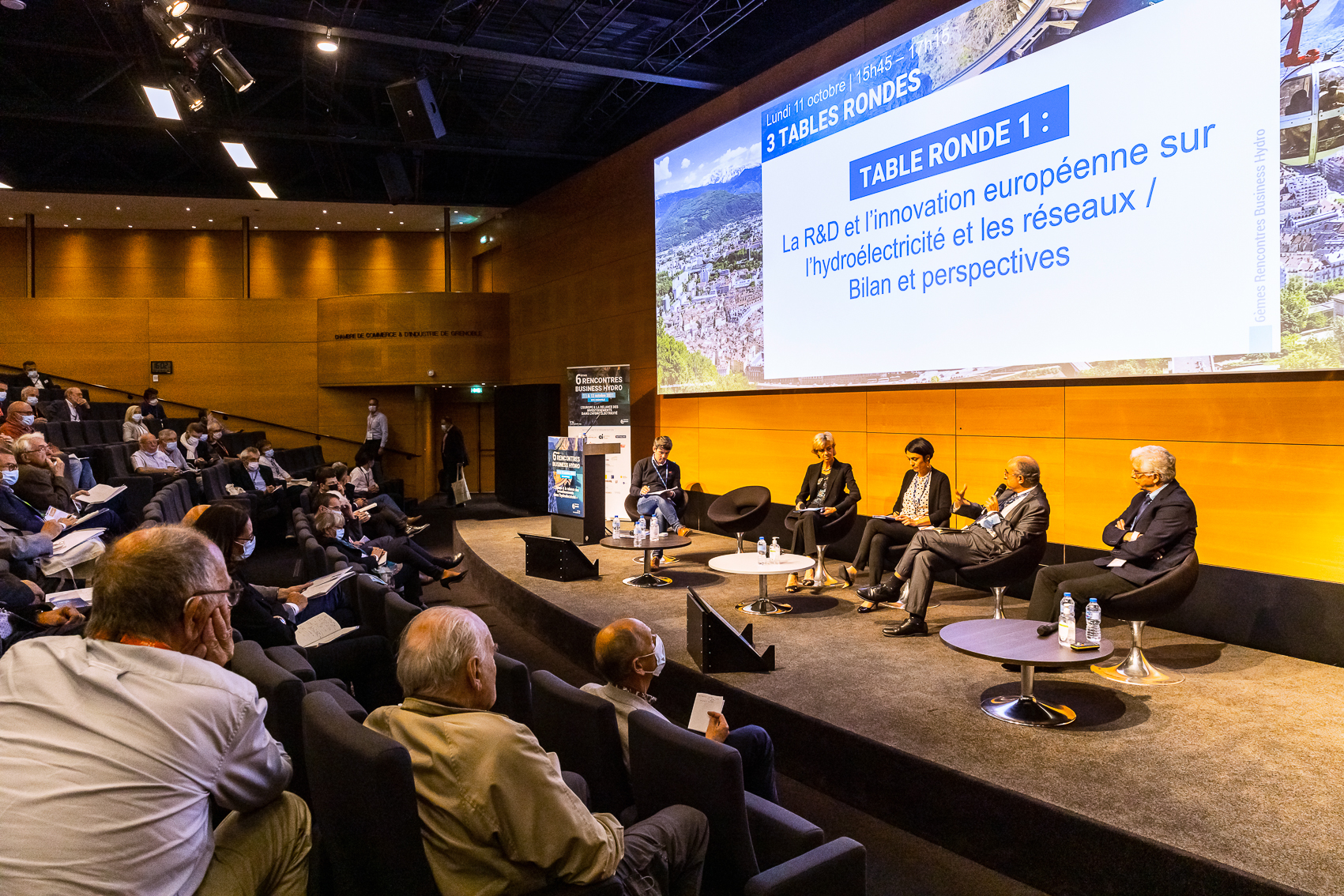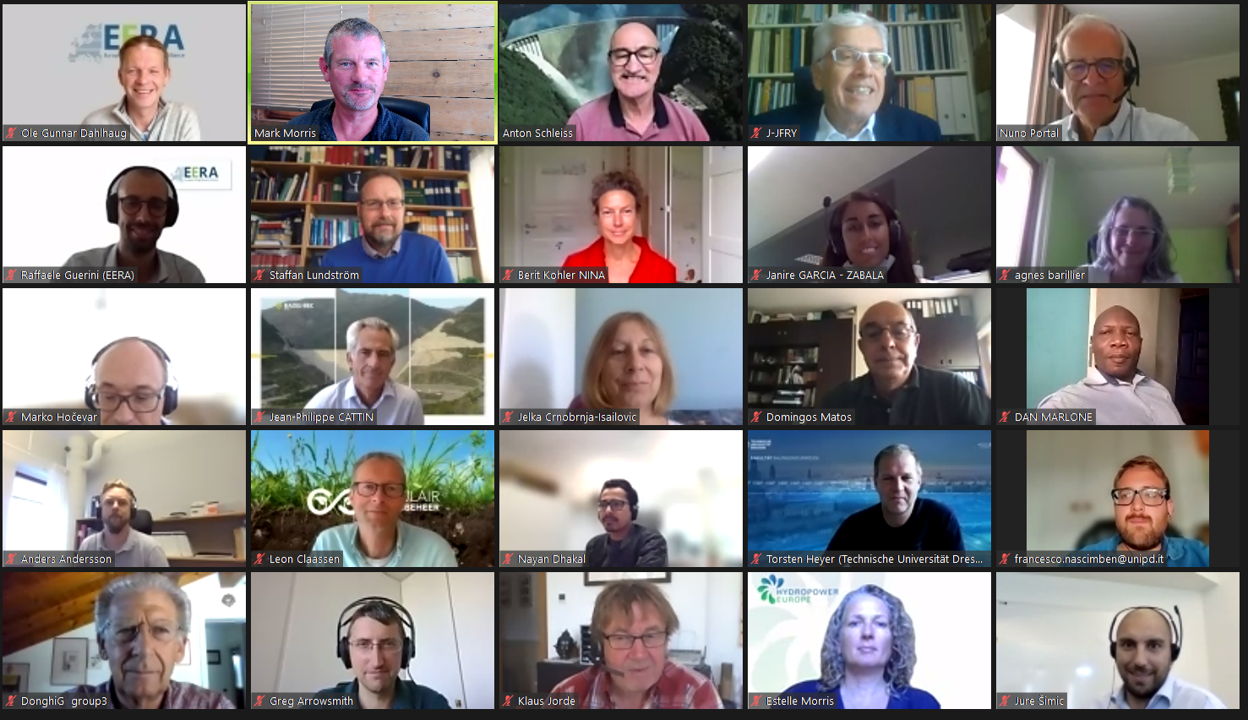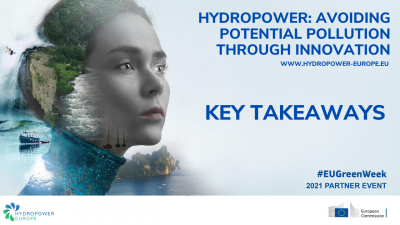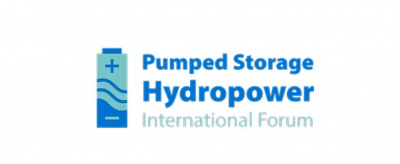Latest News
Participation at Hydro21 in Grenoble
HYDRO 21 is an event that gathered about a thousand participants over two days in Grenoble in person and by videoconference. Two of our colleagues, Dr. Anton Schleiss and Dr Jean-Jacques Fry were invited to participate in order to share their expertise about the hydropower sector in Europe. Jean-Jacques Fry participated in the first round table dedicated to "The place of hydropower in the European electricity sector". Christophe Leininger, General Delegate of UFE (French Union for Electricity) introduced the debate. He recalled that the European Commission listens to the federations because it does not have the time to meet with each one of the actors. Which means, the action carried out with Eurelectric on the taxonomy made it possible to authorise small run-of-river power stations to be supported by sustainable finance and to avoid that PSH power stations not appear as a means of electricity production. The very strict environmental protection criteria have been reduced from those of the Water Framework Directive. He points out three major problems:
Dominique Grand recalled that the method of F. Wagner, President of the European Commission of Physics, applied to Germany and France for 2050, shows that one quarter of solar and wind production must be stored at a rate of one to two times a day. This results in such a quantity that the solution does not currently exist. Prof. Nouredine Hadjsaid insisted on the fact that stability and safety are the priority, as evidence, he quoted the study of the network in France which evaluates the impact of a 1 day black out at 1% of GDP. Jean-Jacques Fry remarked that the European Commission has given several positive signals towards hydropower:
The conclusions of these debates have clarified the strategic actions, to which the HYDROPOWER EUROPE Forum and the future ETIP Hydro have contributed and will contribute.
He highlighted that the electricity spot market conditions at the moment are very favorable and it seems that this situation may continue in future especially when the massive subsidize in the other renewables like solar and wind will be considerable diminished towards free market conditions. By eliminating the distortion of the market hydro will have a bright future and will be an important and highly needed catalyst for the energy transition. At the example of Switzerland he stressed that future development will be towards flexibilization of hydro including the increase of winter generation mainly through the extension of reservoir storage by, not only heightening existing dams, but also building new multipurpose dams at new lakes which will or already have formed in valleys freed by glacier retreat. Besides the already ongoing development of pumped-storage, another focus will be the increase of the installed capacity in existing power houses by adding new parallel underground waterway systems, which allow to concentrate the generation on a few hours per day or on short periods when the market prices are highest. He also said that a consensus with environmental requirements can be found by innovative mitigation solutions which may even improve biodiversity compared to the actual situation at existing and future hydropower schemes.
|
Hydropower Dissemination Event: “Hydropower, a catalyst for the energy transition in Europe”The theme of this year's SHF HydroES 2021 was "Hydropower, a catalyst for the energy transition in Europe". This theme summarises the vision that the HYDROPOWER EUROPE forum has been promoting since 2018. It was the occasion for the forum to present its vision, on the first day of the meetings, September 22, 2021, to an audience of about a hundred people, thirty of whom were in the room and the rest online. This day was part of the events accompanying the European Sustainable Energy Week (EUSEW 2021). It was divided into four sessions presenting successively the context and its challenges, the deliverables after 2.5 years of consultation: the Research and Innovation Programme (RIA) and the Strategic Roadmap for Industry (SIR) and finally, the perspectives. SESSION 1: Current challenges for hydropower in Europe
|
> LAST DAYS TO REGISTER! HYDROPOWER EUROPE Forum Dissemination Event in series with the HydroES 2021 conference in LyonThe HYDROPOWER EUROPE project is built on the ambition to achieve a research and innovation agenda and a strategic industry roadmap for the hydropower sector, based on the synthesis of technical fora and transparent public debates through a forum that gathers all relevant stakeholders of the hydropower sector. Following this vision over the past 2 years, the HYDROPOWER EUROPE Forum has been created to facilitate communication with all stakeholders within the European hydropower sector. The Forum now comprises nearly 600 different representatives and has been active in helping to develop the hydropower research and innovation agenda and strategic industry roadmap. A special one-day session will be held – in series with the HydroES 2021 conference in Lyon - to introduce the conclusions from this extensive programme of consultation and planning. Participation in this day event is free, whether online or in person. The HydroES 2021 hybrid conference runs from 22-24th September 2021, will present the progress of scientific research and technical innovations aimed at better understanding and overcoming these issues. Participation to this event can be either online or in person at ENS, Lyon. See here for full programme details 22nd September 2021 - HYDROPOWER EUROPE Dissemination EventIntroducing the conclusions from the HYDROPOWER EUROPE Forum’s extensive programme of consultation and planning. Session 1: Challenges for hydropower in Europe today Registration is free but mandatory. Register HERE
|
Joint event EERA JP HYDRO and HYDROPOWER “Sustainability and the acceptability of hydropower as part of the clean energy transition”*Recording of the webinar below* On the 2nd of September, over 60 participants attended the webinar: “Sustainability and the acceptability of hydropower as part of the clean energy transition” hosted jointly with EERA JP HYDRO and HYDROPOWER EUROPE. The event, organised on the framework of the European Sustainable Energy Week 2021 (EUSEW21), counted on four experts who shed some light on the socioeconomic and ecological consequences of hydropower, and how they can be mitigated to achieve the full potential that hydropower can reach to in the clean energy transition. Anton Schleiss, honorary president of ICOLD and professor emeritus at EPFL, opened the session and introduced the main topic of the event. Ole Gunnar Dalhaugh, acting Coordinator of EERA’s Joint Programme Hydropower, acted as chair of the session.
Main findings:
Ms Köhler started by detailing the environmental and socioeconomic consequences of hydropower at different levels, where the perception at local community level is usually the one which creates the most problems to successfully implement hydropower projects. For this reason, she stressed the importance on the research of social acceptance to avoid unnecesary conflicts, promote social sustainability and the clean energy transition of the region.
Ms Barillier presented us with some successful examples where the environmental impact of hydropower had been mitigated. She concluded that it was imperative to work with stakeholders and have a long-term commitment in order to reduce it.
Mr Lundström expressed that, without mitigation technology, there is a risk that the increasing regulation affects the environment and the society in a negative way. In this sense, flexible hydropower can have a key role in environmental mitigation.
Mr Portal made an overview of EDP Produção 's history and the challenges he has faced during the years that he has worked there. He expressed his concern about the 2050 challenges. To name one: it is foreseen that the demand of electricity will triple, and this will need to be achieved with zero-carbon emission technologies. Poll on provocative statementsAt the end of the presentations, the participants responded to nine questions that had been prepared by the speakers in the form of polls (1 do not agree - 10 strongly agree):
Closing remarksAnton Schleiss and Ole Gunnar Dalhaugh took the responsibility of making some final remarks: Presentations have shown that hydropower will have a key role in the energy transition, but there are some challenges to be addressed. More research and awareness about flexibility, social acceptance, especially local constraints, and environmental mitigation are what will make the role of hydropower evolve. Mr Schleiss concluded: "It is always the goal to create a win-win situation, even if it takes a long time to achieve that among all the stakeholders"
You can also access the recording of the session HERE.
|
Anton Schleiss at the World Hydropower CongressAs coordinator of Coordinator of HYDROPOWER EUROPE, Anton Schleiss was invited to participate to a pre-recorded session of World Hydropower Congress, organised by the International Hydropower Association (IHA) discussing the challenges that the sector is facing in different countries /regions and sharing priorities ahead of the United Nations Climate Change Conference (COP26). Anton Schleiss presented the goals of HYDROPOWER EUROPE and answered to the question « What would you say to campaigners who say that no new hydropower plants should be built in Europe? » He announced also the HYDROPOWER EUROPE dissemination event on September 22 in Lyon during the conference Hydro ES. You can view a recording of the session below. |
Register to EERA JP HYDRO & HYDROPOWER EUROPE Joint Event: Sustainability and acceptability of hydropower as part of the clean energy transitionHydro Power Europe invites you to register for the “Sustainability and the acceptability of hydropower as part of the clean energy transition” event hosted jointly with EERA JP HYDRO on 2nd September at 9.30 (CET). Held in the frame of the EUSEW 2021 Sustainable Energy Days, the session will show how pumped and storage hydropower can address environmental and social issues more sustainably and contribute to the cost-effective integration of variable renewables and assurance of the security of supply. |
HYDROPOWER EUROPE FORUM invites you to the Hydropower and Environmental Sustainability eventHYDROPOWER EUROPE FORUM invites you to uncover the Research and Innovation Agenda and the Strategic Industry Roadmap at a three-day conference “Hydropower as a catalyst for the energy transition in Europe” starting on Wednesday, 22 September 2021, at 08:30 (CET). |
IEA Hydropower Technology Collaboration Programme - Annex XVI - WorkshopOn behalf of Hydropower Europe, Prof. Anton Schleiss was invited as a speaker to the online workshop organized under the IEA Hydropower Technology Collaboration Programme on July 1st 2021. Prof. Schleiss made a presentation entitled "Hydropower Europe Forum - Hidden and Untapped Hydropower Opportunities in Existing Infrastructures (see presentation) The purpose of the workshop was to share experiences on the development of Hidden and Untapped Hydropower Opportunities around the world (see programme). Further information on IEA TCP HYDROPOWER - Annex XVI can be found under https://www.ieahydro.org/work-programme/annex-xvi-hidden-hydro |
HYDROPOWER EUROPE hosted a Partner Event about potential pollution in hydropower during the EU Green Week 2021On the 8th of June 2021, over 70 of the almost 100 registered attendees joined the experts in a roundtable discussion on the topic “Hydropower: how to avoid potential pollution sources and to mitigate environmental impacts by innovative measures and concepts” to shed light on good practice that should serve as the basic standard for hydropower deployment. |
HYDROPOWER EUROPE becomes the official partner of International Forum on Pumped Storage HydropowerThe International Forum on Pumped Storage Hydropower (PSH) has become the leading global platform for multidisciplinary collaboration in overcoming the common barriers to sustainable PSH development. On the 25th of May, 2021 the Forum held its second meeting where HYDROPOWER EUROPE participated. |
Latest News
EVENT: Developments and biodiversity of watercourses. 8-10 November 2022
"Aménagements et biodiversité des cours d’eau" (EN: "Developments and Biodiversity of watercourses") is a conference organised by the Societé Hydrotechnique de France (SHF), next 8-10 November 2022 in Strasbourg, France. About the confere...
CONFERENCE: "QUO VADIS? Innovation potential of Hydropower" 27 - 28 October 2022
"QUO VADIS? Innovationspotential der Wasserkraft" (Innovation potential of Hydropower) is a conference organised by IBI- Kompetenz, the multidisciplinary platform for e...
JOINT LETTER: Renewables displace fossil fuels - the Innovation Fund must recorgnise this
Joint letter signed by: Bioenergy Europe, the European Heat Pump Assocition (EHPA), the European Renewable Energies Federation (EREF), the European Solar manufacturing Council (ESMC), the European Solar Thermal Electricity Association (ESTELA), Solar Heat Europe (ESTIF), Solar Power Europe, the A...
ETIP HYDROPOWER EUROPE: The permanent and common voice of Hydropower in Europe
ETIP Hydropower Europe (ETIP Hydropower) is a new project in the EU programme ...
Prof. Anton Schleiss at the 7th IAHR Europe Congress (Greece)
Prof. Anton Schleiss, from the International Commission on Large Dams (ICOLD - CIGB), was invited as a keynote speaker for the opening session og the ...
Hydro Power Industry Guide 2021/22 by VGBE
After the success from "Hydro Power Industry guide 2020/21", our colleagues from VGBe wanted to offer us the new guide from this year: “Hydropower Industry Guide 2021/22”. vgbe´s ...
POSITION PAPER: Hydropower as a catalyst and facilitator for the clean, safe and independent energy transition in Europe.
Key Messages: Given Europe’s ambition to raise the renewables target to 45%1 hydropower is critical to ensure Europe’s energy system has the necessary renewable electricity and flexibility to protect grid stability from intermittent renewable energy, to sustain the gr...
NEW PUBLICATION, Hydroscience Journal: "Hydropower, a catalyst for energy transition in Europe"
On the context of HydroES 2021 (22 September 2021), Hydropower Europe had the chance to present its vision and results achieved during three years of consultations. Some of the conclusions are: Hydropower still has a great potential for development Hydropower sector needs...
HYDRO 2022 Strasbourg: How to promote future hydro development in Europe with a sustainable impact?
The HYDROPOWER EUROPE project (2018-2022), funded from the European Union's Horizon 2020 research and innovation program, has released its final deliverables: a Research and Innovation Agenda (RIA) and a Strategic Industry Roadmap (SIR) for the hydropower sector. The challenge is...
Webinar 28 february 2022: What Research and Innovation are Needed to Tap More Hidden Hydro Opportunities in the Future?
The IEA Technology Cooperation Programme (TCP) on Hydropower (also known as IEA Hydro) is a working group of the International Energy Agency's member countries and others that have a common interest in advancing hydropower worldwide. Under the work programme Annex XVI...













